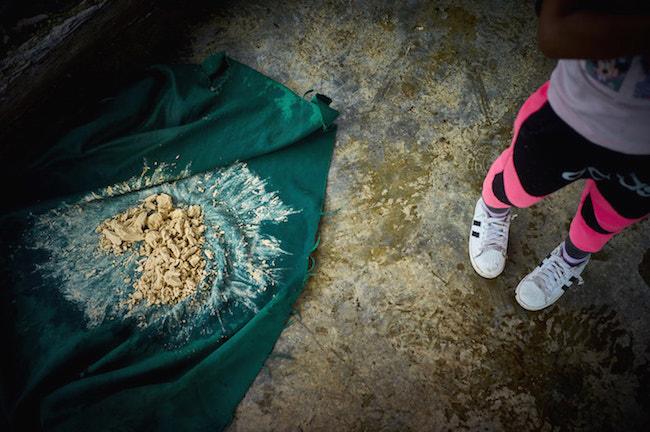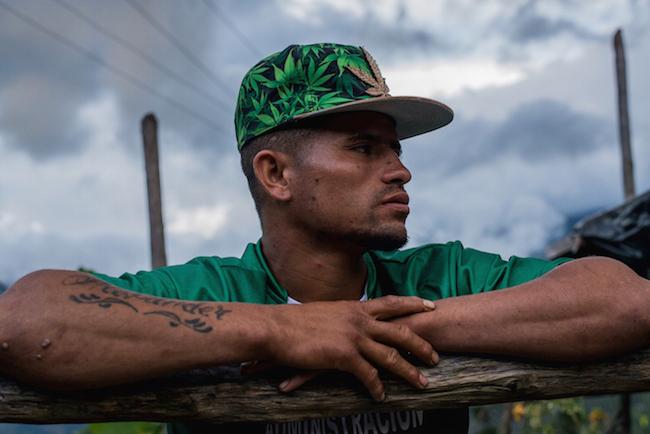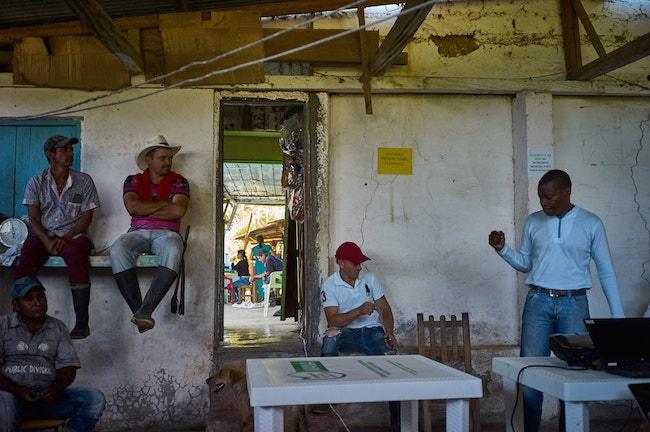
This piece is second in a two-part series on crop substitution efforts in post-peace accord Colombia. Read part one here.
Paola* is worried about the war coming back. The 30-year old mother of four and member of the community board in Briceño, a municipality in the Antioquia department in northwest Colombia, thought the bad times were over, since the signing of last year’s peace agreement between the Colombian government and the Revolutionary Armed Forces of Colombia (FARC).
But Paola has reasons to fear the conflict’s return: her husband was killed in circumstances she still doesn’t understand during the 52-year conflict that caused 1.7 million to be killed, disappeared, or missing in action, and displaced seven million more. Despite her loss, she emerged as one of Briceño’s strongest leaders—when the mayor dragged his feet on paving her village’s road, she cornered him at public events until he followed through; when her own community failed to show up for meetings, she was equally demanding. Her deep involvement in the community led to her election as one of four community representatives for a crop substitution program being piloted in Briceño in the wake of the accords. The program offers incentives to growers to uproot their coca and switch to legal agricultural products, through in-kind and cash payments, accompanied by technical assistance and broader rural reforms.
Paola worked on a team of national and local government representatives, FARC members, and the UN Office on Drugs and Crime to develop and promote the program. Since July of last year, as an agreement seemed imminent, Paola traveled from village to village, heralding the virtues of crop substitution to often-ambivalent communities hesitant to give up growing a crop that has ensured their livelihood for the past 15 years. After a promising start, however, Paola isn’t so sure the program will do much to alleviate poverty or quell violence in the region, a narcotrafficking hotspot during the Colombian conflict.
Since uprooting their coca plants, as explored in part one of this piece, townspeople have grown desperate for new sources of income, she says, as the government fails to meet its payment agreements: “The government is late in their payments,” she says. “If they don’t give us the money they promised for growing other crops, we’re going to be left with nothing, hungry and suffering.” Paola explained that she has watched the young men of the village who once harvested coca leave for nearby municipalities, where coca farming continues.
Paola is now demanding answers and accountability about delays and shortcomings from the government team she worked alongside, including the exclusion of harvesters from the program the lack of promised technical assistance, and why communities are no longer being consulted.

These aren’t the only sources of preoccupation: only a few months after the auspicious launch of the new crop substitution program, violence is on the rise as newly-forming armed groups, the police, and the military vie to take control over power vacuums left by the demobilizing FARC. Rumors circulate among townspeople and local media that a new illegal armed group is emerging from the ranks of former FARC combatants, and that they have been fighting neoparamilitary groups on the other side of the Cauca River which borders Briceño. In late October, for the second time in just two months, unknown assailants assassinated a community member linked to the coca substitution program. “We’re just left here in the middle, not knowing what is happening or what to do,” Paola whispers, out of earshot from her children.
While things fall apart in Briceño, events unfolding in Bogotá also reveal a lack of follow-through on the agreements. Just last week, efforts to legislate the agreements gutted some of their most essential points. Analysts, lawmakers, and the FARC itself are concerned that the substitution program and the peace process as a whole are at risk.
A Rising Tide of Violence in the Countryside
Beyond Briceño, violence spreads throughout the region; in the nearby municipality of Tarazá, a well-known community promoter of coca substitution was gunned down and knifed to death on October 19th—also by unknown actors. Authorities say the primary suspect belongs to an increasingly powerful criminal group formed by former paramilitary leaders. The so-called “Gulf Clan” has grown by seizing land and the parts of the coca production system formerly controlled by the FARC. Gulf Clan members also pressured government officials promoting the substitution agreement into desisting their promotion the program across Tarazá, and the group has threatened to kill residents who participate in it.
The assassinations mark a trend that is characterizing postconflict Colombia: on the one hand, the country is witnessing a remarkable drop in deaths related to the armed conflict, which fell from 1,293 in 2008 to 210 in 2016— which constitutes a 92% reduction since 2002. The peace accord has opened regions in the country that have been too unsafe to travel to or work in for decades, in zones that are experiencing a surge in attention and state investments.
Yet not all territories are equally peaceful, and certain regions are experiencing a spike in violence. In some municipalities, violence has risen 100% between 2016 and 2017 alone. The coca trade is not the only factor, but it certainly plays a role. While the center of the country is relatively calm, violent clashes between coca eradication squads and growers have stalled the substitution process, near the border with Venezuela, in Catatumbo. In the Amazon state of Guaviare, FARC members once committed to peace are growing disillusioned with the demobilization process and reverting to old dynamics. On the Pacific coast, where the most coca is grown, a tangle of FARC dissidents, former paramilitaries, other guerrilla groups, criminal gangs, and Mexican narcotraffickers vie for control of the cocaine trade.
This crisis came to a head when seven peasants in the Pacific municipality of Tumaco were killed while defending their crops against anti-narcotics police on October 5. A few weeks later, the National Coordinator for Coca, Cannabis and Poppy Growers, the largest organization representing the interests of illicit crop growers in Colombia responded to these deaths by declaring a national strike denouncing forced eradications, violence, and failure of the peace agreements. The strike has added momentum to a rising movement of different social groups calling for an end to the murder of community leaders.
The UN estimates that in 2017 alone, 106 community leaders and activists have been killed, and that a FARC member is assassinated every six days. The battle between new and old groups to lay claim to previous FARC territory has come to define the current period of supposed demobilization and peace, altering the nature of armed conflict. Colombia has always been termed a “country of regions,” where each territory varies widely in terms of geopolitics, history, and local dynamics, but the FARC’s hierarchical and centralized structure in some ways established some minimal coherence across the country throughout the 52 years of conflict.
With the FARC’s demobilization, those areas where the Colombian state lacks control fragment into a chaotic mosaic of criminal micro-powers. Today, up to 1,000 FARC dissidents live in 48 municipalities, while neo-paramilitary structures exist in 275 different municipalities in 28 departments. The old landscape of violence was, some argue, at least predictable and controlled by a disciplined guerilla force. Now Colombians in coca-growing regions face something more like a war of all against all.
Is Bogotá to Blame?
After the Tumaco massacre, an international commission including representatives from Colombia’s local and national government, the Organization of American States (OAS), the UN, and several journalists traveled to the site of the killings to investigate. As they approached, anti-narcotics police fired at them. The incident was illustrative of the lack of coordination and at times active discord between different parts of the Colombian state, especially its military and civilian branches.
From the very first peace negotiations in Havana in 2012, all parties agreed that a coordinated and “comprehensive”—a word found in virtually all of the 310 pages of the agreements— strategy would ensure a sustainable “post-conflict” era. A transitional institutional structure would tackle the country’s biggest problems with new agencies dedicated to the redistribution and formalization of land (the National Land Agency), transitional justice (the Special Peace Jurisdiction system), and the eradication of coca farming (Direction of Illicit Crop Substitution), all coordinated by the Agency for Territorial Renewal.
Despite that agreed-upon framework, the government has launched a two-pronged and contradictory strategy of forcefully eradicating 50,000 hectares of coca, while simultaneously allowing the crop substitution program to allow municipalities to voluntarily substitute another 50,000 hectares of coca plants for legal crops in consultation with locals. The division of labor within the state reflects this strategy: the Ministry of Defense is forcefully eradicating, and the Ministry of Postconflict is offering a voluntary substitution program. This process divides the country into two parts: one worthy of voluntary substitution and of the peace agreements, and one excluded from both, where the logic of the armed conflict would continue. By extension, it deigns some citizens as participants in the new national project of peace, and excludes others. Perversely, the state hasn’t made public the reasons why some territories and its inhabitants are treated one way or the other, letting the arbitrariness of the decision loom as a threat to those who do not abide by the substitution agreements.

While the Obama administration eventually came out in support of the peace process in Colombia, the Trump administration’s relationship to the peace process has been marked by indifference until clashes over the rise of coca growing in Colombia led Drug Czar William Brownfield to blame the peace process, the FARC, and even the cocalero social movement for increased cocaine production and implicitly, for the recent rise in drug deaths in the U.S. The administration has defended the historic militarized strategy of forceful eradication and aerial glyphosate fumigation—ceased in 2015 after the Colombian Supreme Court declared it illegal due to its indiscriminate health and environmental impacts.
In this way, the U.S. government has emboldened the Ministry of Defense to continue with its militarized agenda, and the criminalization of coca growers became the backdrop to juridical persecution and assassination of cocaleros. Instead of consolidating the rule of law and unifying the country, this two-pronged coca eradication strategy has only reignited distrust and antagonism towards the government, creating new states of exception.
To make matters worse, the transitional institutional structures created by the agreements still exist on paper alone. The implementation of the first phase of the crop substitution program, which ostensibly provides cash handouts to incentivize growers away from coca, has been unevenly applied in different regions, defined by improvisation and the repeated failure of the government to meet planned deadlines. A more important second stage of the crop substitution program would involve long-term structural changes in the organization of local economies, land reform, infrastructure, and access to state services. There is little to suggest that this second stage, which would aim to prevent at-risk regions from returning to coca cultivation, will fare any better than the first.
Undoubtedly, a lack of resources does serious damage to the peace process; the Colombian government counted primarily on oil revenue to finance the agreements, basing their budget on the 2014 rate of $100 a barrel. But prices plummeted as low as $29 in 2016, making funding a critical issue.
But the problems run deeper than money. They are rooted in the Colombian political system itself. Given Bogotá’s historic distrust of local governments, the renewed centralization of governance via the accords is a major challenge to the peace process. The central government’s tendency to deprive local government power and resources fuels a vicious cycle, where municipalities remain weak, underfunded, and thus more prone to corruption and inefficiency. Equally destructive is the tendency within the central government to assign roles in new agencies on the basis of political debts and favors.
As the May 2018 presidential and congressional elections hover on the horizon, as many candidates increasingly see support for the peace accords as a political risk. The approval rating for President Juan Manuel Santos had dropped to 24% by June, the most recent polls available. Some members of Congress—even more unpopular than the president with an 18% approval rating—have stopped showing up in order to avoid having to vote against the agreements. Those that do show up are unable to summon enough cohesion to pass the most basic measures needed to implement the agreements.
Recently, Congress gutted the Special Jurisdiction for Peace system as it passed into law, and failed allot the proposed sixteen seats for alternative political parties which would represent the territories most affected by the armed conflict—an essential component of the expanded political participation negotiated in the agreements.
From the outset, the state poorly designed the transitional structures of the peace process. According to the Fundación Ideas Para la Paz, the Direction of Illicit Crop Substitution may not be able to cover payments to the increasing number of growers with whom it has signed substitution agreements, much less guarantee deeper structural interventions that the substitution program promises in its second phase. Meanwhile, land subsidies doled out by the National Land Agency will scarcely make a dent in the mammoth land inequality of the country.
Hung out to dry by the government, these agencies are left scrambling for funds elsewhere— with dangerous results, according to former FARC commander Luis Bernardo Piedrahita, also known as “Roman.” Piedrahita, credited with helping to defeat paramilitaries from Briceño in the early 2000s, feels the FARC is being systematically excluded from the implementation of the agreements they helped create: “The Agency for Territorial Renewal is working on its own without consulting the FARC team, which goes against everything we agreed,” he said to me in a recent interview.
Why would the agency primarily responsible for implementing the regional development aspect of the agreements exclude the FARC and local communities? In doing so, they put peace at risk and undermine hopes for creating a better country. Their actions could be related to the funding Colombia receives from United States Agency of International Development (USAID). The U.S. government still considers the FARC a terrorist organization, and forbids their participation in the implementation of USAID projects, limiting their ability to be included in such projects. For the same reason, the United States does not support the coca substitution strategy.
Amid these challenges and failures, some have begun to question the intentions of the peace agreements, and whose interests they really represent. “They take away your coca, which is work, your food, your work,” complained a former coca grower, who was helping to fix a road to Briceño, which the government does not maintain. “What does a person with a family do without employment and food?”
However, the fact that communities like those in Briceño, Guaviare, and Tumaco are demanding the implementation of the agreements suggests these are no longer defined as a pact between two parts, nor will they be limited to a passive acceptance of the government’s interpretation of them, as was the case in previous substitution programs. Instead, like no other point of the agreements, the cocalero communities are providing the most tangible and visceral defense of the Peace Accords, and showing how these can provide a rallying point in which organized communities can leverage a deep transformation on the local and regional levels from below.
*Psuedonym used to protect the source.
Isabel Peñaranda is an anthropologist from Columbia University and MA candidate in history based in Bogotá, Colombia. She studies the implementation of the Havana peace agreements, and currently works in the Amazon region of Caquetá.
Gerald Bermúdez is a photojournalist who has been documenting the Colombian armed conflict for over six years. His book of portraits of FARC guerrilla members, 52, is forthcoming. Twitter: @geraldkurt.

